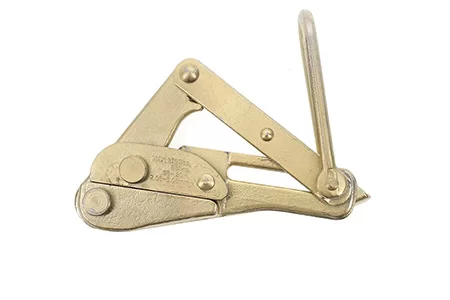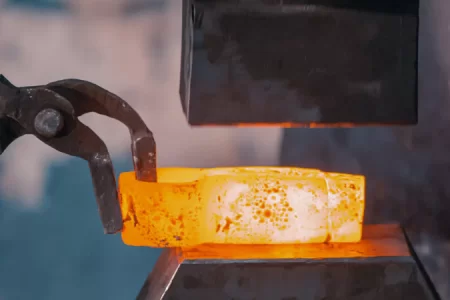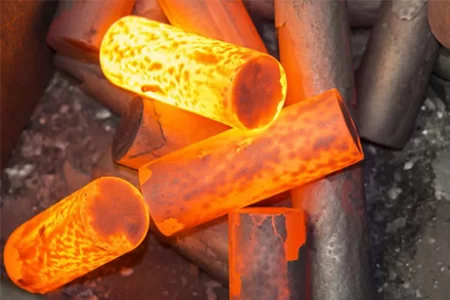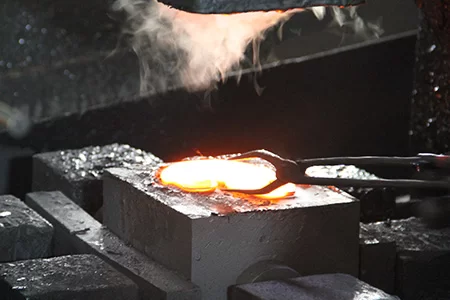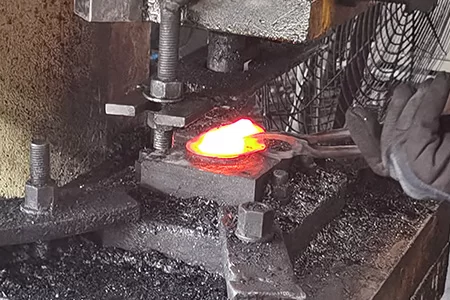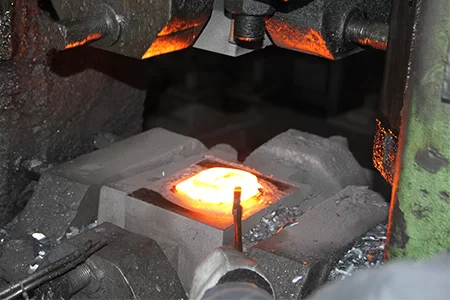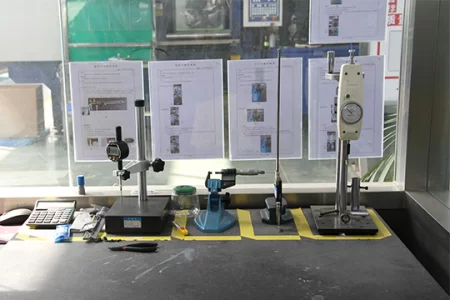By sharing knowledge, experience and views in the field of forging technology, we help you understand, learn and apply relevant technologies.

Hulk Metal Forging Technology
Share technical experience
-
Home>
-
Blog>
-
Technology>
Metal Forging Equipment and Technologies

Metal forging is one of the oldest and most essential manufacturing processes, where metal materials are subjected to pressure or impact forces to deform them into the desired shape and size. Since the Industrial Revolution, metal forging has undergone significant technological advancements, evolving into a critical method used in various industries, including aerospace, automotive, energy, and military sectors. Metal forging is indispensable, particularly for manufacturing parts that require high strength, durability, and reliability.
As industrial technologies have developed, metal forging has moved beyond traditional manual operations to incorporate advanced equipment and processes. This evolution has enhanced production efficiency, product quality, and overall operational precision. This article delves into the various equipment and technologies employed in metal forging, shedding light on their significance in modern manufacturing practices.
Advancements in Metal Forging Equipment and Technology
What is Metal Forging?
Metal forging is a process that involves applying external forces, often at elevated temperatures, to reshape metal materials plastically. The goal is to alter the shape and dimensions of the metal while optimizing its internal grain structure, improving its strength and durability. Unlike casting, cutting, and stamping, forging produces components with superior mechanical properties, such as increased tensile strength and fatigue resistance.
Comparison with Other Metalworking Methods
Casting:
Casting is the process of pouring molten metal into a mold to solidify and take shape. While it is well-suited for mass production of complex-shaped parts, cast components can suffer from defects such as porosity, inclusions, and lower strength. Forging, on the other hand, eliminates many of these issues and produces stronger and more reliable components.
Cutting:
Cutting involves removing material from a metal workpiece using tools like drills or lathes. This method is ideal for creating high-precision, intricate shapes. However, it results in higher material waste and does not enhance the metal's internal structure as forging does.
Stamping:
Stamping uses dies and presses to form thin sheets of metal into the desired shape. It is suitable for large-volume production of simple parts but is less efficient for creating high-strength, complex components like those forged metals are used for.
Overview of Metal Forging Equipment
The metal forging process requires specialized machinery, each designed to deliver varying levels of force and speed depending on the material being forged and the complexity of the part.
Types of Forging Machines and Their Functions
Hammer Forging:
Hammer forging utilizes repeated blows from a heavy hammer to deform the metal material. This process is ideal for producing high-strength components and parts with complex geometries. Traditional hammers use gravity to drop heavy weights on the metal, while modern pneumatic or hydraulic hammers use controlled force to achieve better precision.
Hydraulic Presses:
Hydraulic presses utilize fluid pressure to exert a steady and uniform force on the metal. They are perfect for high-volume production and offer excellent control, making them ideal for precise forging operations. Hydraulic presses are especially effective for cold forging and precision forging applications.
Vibratory Forging Machines:
Vibratory forging uses vibration energy to deform the metal, reducing the forces required and minimizing material waste. This technology is especially useful for large components and parts made from low-alloy metals.
Choosing Forging Machines: Key Considerations
When selecting the appropriate forging machine, manufacturers must consider several factors:
Material Properties:
The hardness, ductility, and other mechanical properties of the material being forged will determine the type of machine required.
Part Size and Complexity:
Large or intricately shaped components may require more sophisticated machines, such as hydraulic presses or precision hammers.
Production Volume:
For large-scale production, automated systems and robotics are often employed to ensure efficiency and consistency.
Forging Dies and Tools
Forging dies are crucial in shaping the metal and controlling the deformation process. The design of the dies plays a vital role in ensuring high-quality forged components.
Die Design Principles:
Forging die designs should account for material flow, heat treatment requirements, production efficiency, and finished part quality. Cooling and lubrication systems are critical to ensure smooth operations and prevent defects in the finished product.
Common Die Materials and Processing Techniques:
Forging dies are typically made from high-wear, high-temperature-resistant alloys or tool steels. These materials undergo heat treatment to enhance their hardness and durability, ensuring they can withstand the high pressures and temperatures involved in the forging process.
Core Technologies in Metal Forging
Hot Forging vs. Cold Forging
Hot Forging:
Hot forging involves heating the metal to a high temperature before deformation. This makes the material more malleable and easier to shape. Hot forging is suitable for most metals, particularly high-alloy steels and titanium alloys, which are hard at room temperature but become more ductile at elevated temperatures.
Cold Forging:
Cold forging takes place at or near room temperature, providing higher dimensional accuracy and surface finish. It is primarily used for producing precise components in small to medium batch sizes.
Comparison of Hot and Cold Forging:
Hot forging is used for parts that require intricate shaping or are made from harder materials, whereas cold forging is ideal for high-precision components and mass production.
Precision Forging
Precision forging refers to using high-accuracy dies and equipment to produce parts with exceptional dimensional precision and surface finish. This method often incorporates computer numerical control (CNC) technology to meet complex design requirements and achieve high-quality forged components.
Open-Die Forging vs. Closed-Die Forging
Open-Die Forging:
In this method, metal is placed between two open dies and shaped through repeated hammering or pressing. While it is versatile and can accommodate a wide range of part sizes, it does not achieve the same high precision as closed-die forging.
Closed-Die Forging:
Metal is placed in a completely enclosed die, which allows for better control of material flow and more precise part shapes. This process is suitable for high-precision components and offers better material utilization.
The Forging Process and Key Technologies
Temperature Control in Forging
Temperature plays a crucial role in metal deformation and microstructure development. Control over the heating and cooling rates during forging can significantly enhance the mechanical properties of the final product. Proper temperature control helps minimize defects such as cracking while promoting optimal grain structure in the forged material.
Material Selection and Treatment
The selection of materials for forging depends on their composition and physical properties. Different metals—such as steel, aluminum alloys, and titanium alloys—require distinct forging processes to achieve desired results.
Post-Forging Heat Treatment and Surface Finishing
After forging, materials often undergo heat treatments like annealing, quenching, and tempering to improve hardness, toughness, and durability. Surface finishing techniques, such as galvanizing, sandblasting, and electroplating, help enhance corrosion resistance and appearance.
Innovations and Developments in Metal Forging Equipment and Technology
With advances in technology, new innovations continuously shape the metal forging industry. Techniques like computer numerical control (CNC), laser forging, and 3D printing are enhancing the precision and efficiency of metal forging operations.
Environmental and Energy Efficiency Improvements
As environmental concerns rise, the metal forging industry is working towards reducing energy consumption and adopting sustainable practices, such as waste recycling and green manufacturing technologies. These innovations aim to minimize the environmental impact of forging operations and contribute to a more sustainable manufacturing process.
Challenges in Metal Forging and Solutions
Despite its many advantages, metal forging faces challenges such as material complexity, microstructure control, and equipment maintenance. Through process optimization, enhanced equipment reliability, and the adoption of advanced testing technologies, metal forging manufacturers can effectively address these issues, boosting production efficiency and product quality.
Metal forging is an essential manufacturing process that plays a pivotal role in producing strong, durable components for a variety of industries. The continued advancements in forging technologies and equipment are making the process more efficient, accurate, and environmentally friendly. With ongoing innovations, metal forging will remain a cornerstone of modern manufacturing, driving the production of high-performance parts across multiple sectors.HULK Metal stands at the forefront of the forging industry, blending traditional craftsmanship with advanced technology to create products that meet the highest standards of performance. With our comprehensive capabilities in metal forging, including hot forging, cold forging, precision forging, and closed die forging, we are able to produce high-quality, durable, and reliable parts for a wide range of industries.
Article Navigation
Article Navigation
Industries
Foundries
-

December.11, 2024
Analysis of the characteristics and main uses of wire grip for conductor
READ MORE
-

July.01, 2024
Difference between hot forging and cold forging
READ MORE
-

June.27, 2024
What are the advantages and disadvantages of the hot forging process?
READ MORE
-

February.28, 2025
Open Die Forging: Exploring the forging process and the key factors in selecting a OEM
READ MORE
-

February.24, 2025
Key Considerations for Closed Die Forging
READ MORE
-

February.18, 2025
Factors to consider when purchasing custom forgings
READ MORE
-

February.14, 2025
HULK Metal's hot forging quality control
READ MORE



